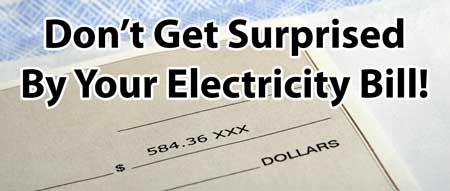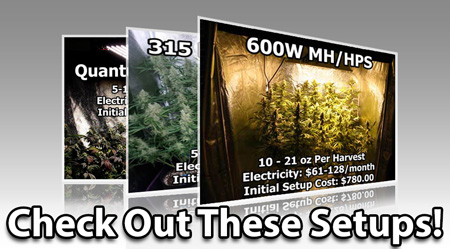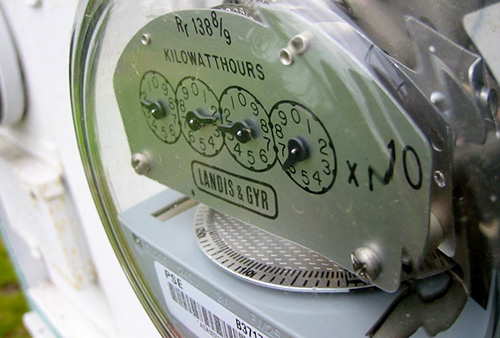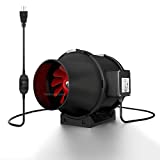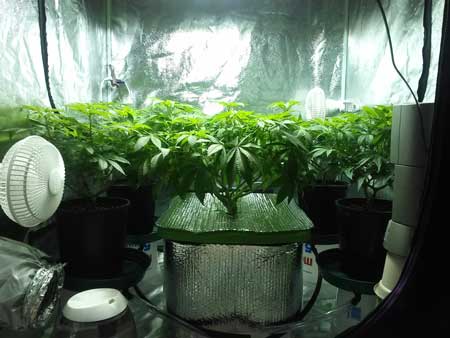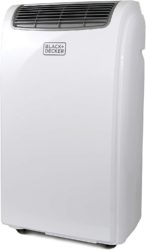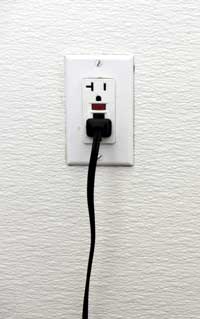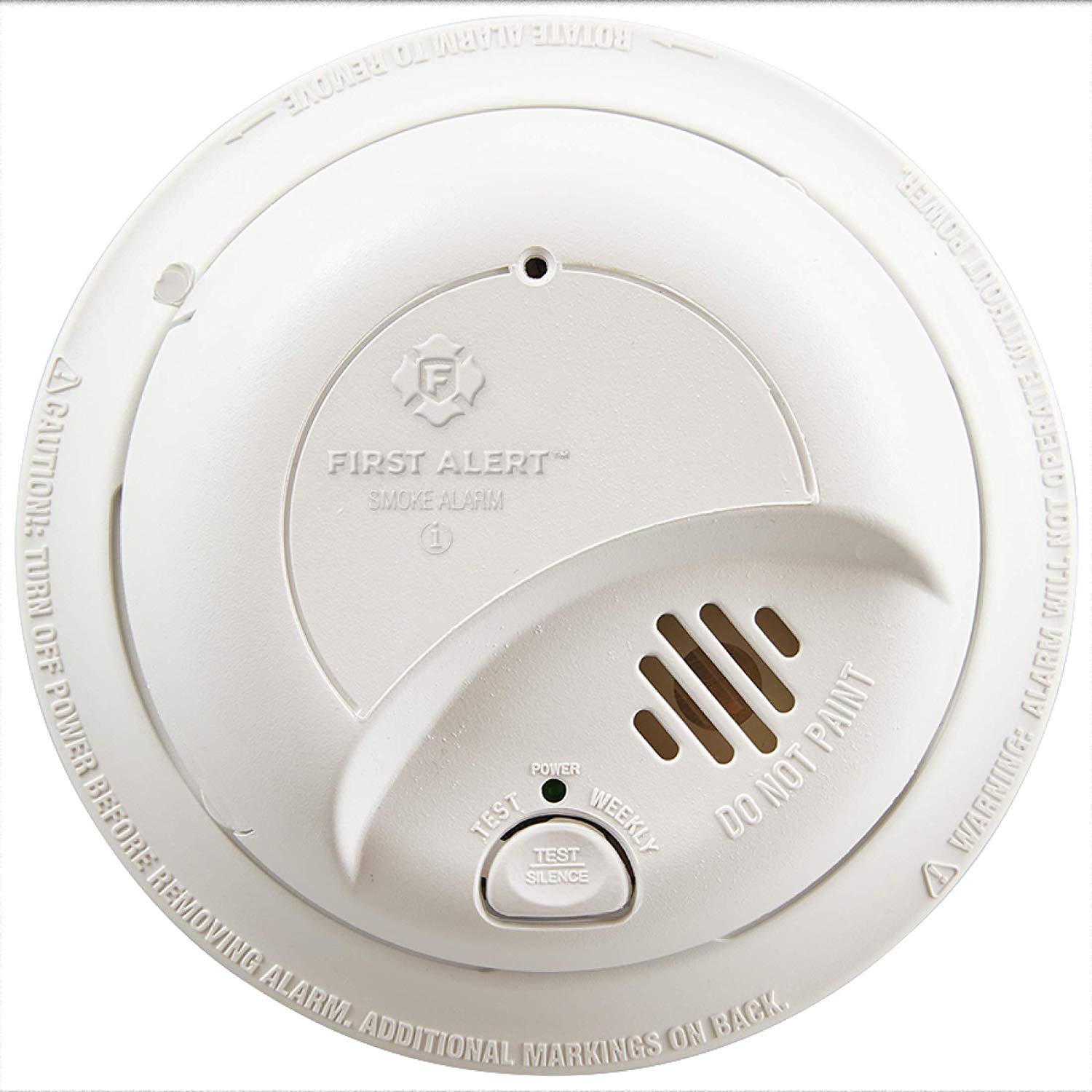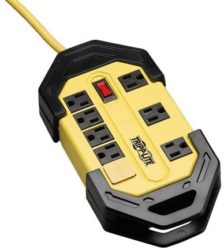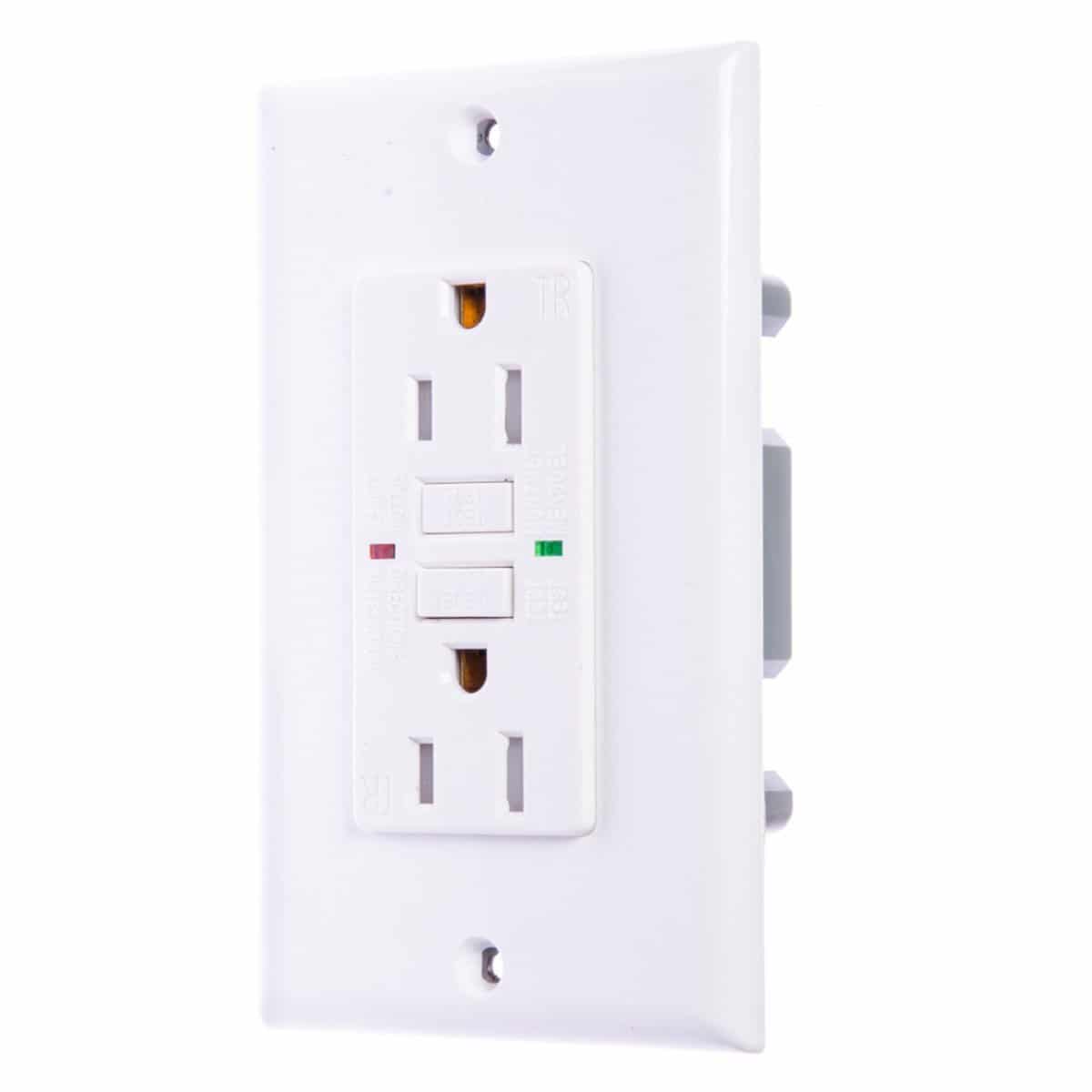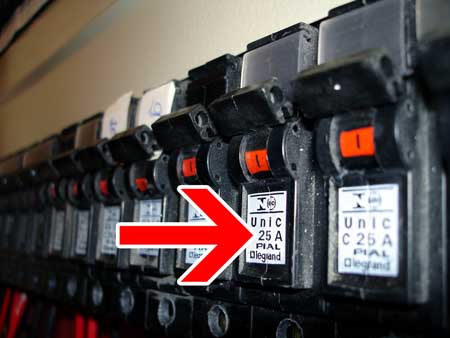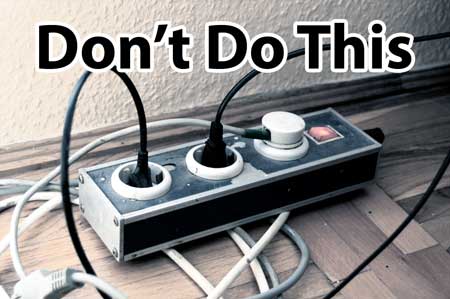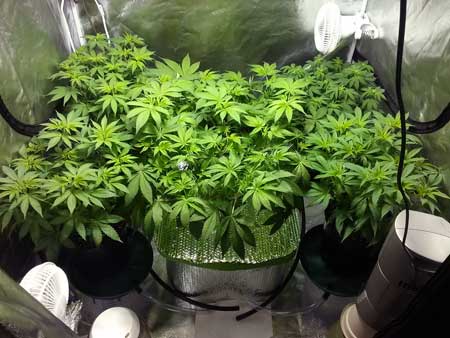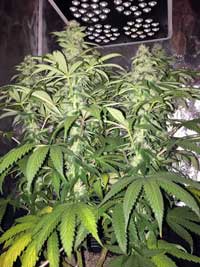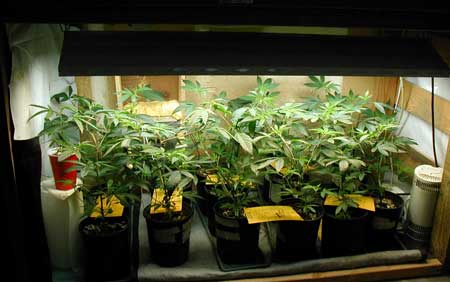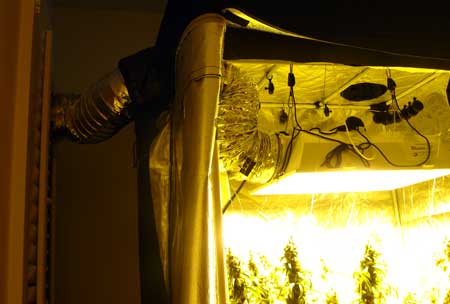by Nebula Haze
Table of Contents
What Should I Expect On My Electricity Bill?
- Figuring Out the Cost of Electricity
- Electricity Cost Calculator (try it out!)
- Estimated Cost Per Month for Common Grow Room Items (lights, fans, pumps, AC, etc.)
- How to Figure Out Cost Per Grow (and cost of each ounce you harvest)
Tips to Save Electricity Without Sacrificing Yields
What Should I Expect On My Electricity Bill?
How much electricity does it take to grow cannabis indoors from seed to harvest, and how much will you be paying for electricity each month?
When growing marijuana indoors, knowing the cost of electricity is essential. However, it can be confusing trying to predict how much it’s going to end up costing you.
Luckily, it’s relatively straightforward to figure your costs in electricity once you have the right information. Let’s go!
Quick Examples of Common Growing Setups
We calculated these electricity prices at the US average electricity cost of $0.12/kWh. Depending on where you live, it can be higher or lower. I’ve heard from growers whose electricity costs half as much, but also some who’s electricity costs twice that or more.
100W LED Average Electricity Cost
- 1-5 oz Per Harvest
- $10/month
- Initial Setup Cost: $613.00
Quantum Board LEDs Average Electricity Cost
- 5-10 oz Per Harvest
- $23/month
- Initial Setup Cost: $1,135.00
250W MH/HPS Average Electricity Cost
- 4-9 oz Per Harvest
- $21/month
- Initial Setup Cost: $605.00
315W LEC Average Electricity Cost
- 5-10 oz Per Harvest
- $29/month
- Initial Setup Cost: $940.00
400W MH/HPS Average Electricity Cost
- 7-14 oz Per Harvest
- $46/month
- Initial Setup Cost: $744.00
600W MH/HPS Average Electricity Cost
- 10-21 oz Per Harvest
- $61/month
- Initial Setup Cost: $780.00
Figuring Out the Cost of Electricity
This guide will teach you how to determine how much electricity you’ll be using each month for your garden. Once you know how much power you’re using, you can easily figure out the cost. I’ll also share a few estimates for the electricity cost of grow lights, fans, ACs, and more, so you’ll have a ballpark figure even if you’re not sure exactly how much you pay for electricity.
You need this information:
- Cost of electricity where you live – this should be on your electricity bill and is usually measured in kWh
- Wattage of light/fan/pump – If you’re not sure, the wattage information is typically on the box. For example, it might say 35W, 150W, or 600W.
- Number of hours the appliance will be running – For example if it’s on 18 hours a day and you want to know how much it will cost each month, then you’d calculate 18 hours multiplied by about 30 days or approximately 540 hours/month.
Here’s the formula which can be used not only to figure out the cost of electricity for the marijuana grow but also the cost per month:
Cost of Electricity x Number of Hours x (Watts / 1000) = Total Cost
Note: You need to divide the watts (W) by 1000 to plug it into the cost formula; this is to convert your number to kW so it plays nice with the kWh measurement you get from the electricity company. I’ll explain below with a few examples.
Real-Life Example with 250W HPS Light
($161 in electricity for the light during the grow)
Let’s look at a previous grow of mine. View the complete grow journal if you want to check it out!
- Cost Electricity – $0.37/kWh (this is what we get charged for electricity, but it’s more than twice the average cost nationwide so you’d probably pay far less than this!)
- Number Hours: 1,746 light hours (total hours with 250W HPS turned on)
Veg: 41 days of 18/6 = 738 hours
Flower: 84 days of 12/12 = 1,008 hours - Wattage/1000: I used a 250W HPS light. So, if I divide that by 1000 I get 0.250 kW for the formula.
Cost Electricity x Number of Hours x (Watts / 1000) = Total Cost
$0.37 kWh x 1,746 hours x 0.250 kW = $161
However, one thing that’s very important to remember when doing any estimations is that although your grow light may account for a lot of your electricity bill, fans and pumps and other things in your grow room also take electricity. It can really start to add up if you don’t pay attention, giving you a much higher-than-expected electricity bill!
Remember to Calculate Energy Cost for Everything That Uses Electricity, Not Just Your Grow Light!
Continuing the above example, in that same grow I also used an exhaust fan, two circulating fans, and for my hydroponic tub I also used a water pump and an air pump. Although they seem like pretty small items, they can start to add up over the length of the grow.
Cost of Electricity for Other Items
(Additional $117 Over the Grow)
- Water pump – $6.12
- Air pump – $3.33
- Exhaust fan – $41.07
- 2 Oscillating fans – $66.60
You can view the full breakdown here. But you can see that these other items cost 3/4 as much electricity as the grow light at $161!
Electricity Cost Calculator
If you want to skip doing all that math, you can plug your information into the calculator below and it will tell you how much money you can expect to spend on electricity. Make sure to look up your local electricity prices as they vary significantly between cities, states, and countries
Estimated Cost Per Month
for Common Grow Room Items
Here are more examples to give you an idea of possible cost projections if your electricity cost $0.25/kWh. $0.25/kWh is higher than most people’s electricity rate so hopefully, your amounts will be much lower than these!
Compare Grow Lights @ $0.12/kWh (average cost of electricity in USA, yours may be more or less!)
Amounts are for if the lights are kept on for 18 hours a day for 30 days (540 hours). In the flowering stage, your lights will be on for only 12 hours/day so for those months you’ll only need to calculate for 360 hours (12 hours x 30 days).
HID Grow Lights (MH/HPS combos, CMH aka LEC)
- 150W MH/HPS
- $10/month
- 2.5-5.5 oz harvest
- 250W MH/HPS
- $17/month <– These are getting harder to find, as many growers in this power range go for a 315 CMH (also known as LECs).
- 4-9 oz harvest
- 315 CMH (called “LEC” when sold by the company Sun System)
- $21/month
- 5.5-11+ oz harvest
- Learn more about CMH and LEC grow lights
- 400W MH/HPS
- $26/month
- 7-14 oz harvest
- 600W MH/HPS
- $39/month
- 10-22 oz harvest
LED Grow Light Examples (recommended models)
- HLG 100 R-Spec
- $7/month
- 1-4 oz harvest
- Electric Sky 180
- $12/month
- 3-6 oz harvest
- Electric Sky 300
- $20/month
- 5-10+ oz harvest
- HLG 300 R-Spec
- $20/month
- 5-10+ oz harvest
Note: These LED models have been personally tested on cannabis plants by me. I’ve tried several different LED models and these have performed the best for yields, ease of use, and especially bud quality. Check out more brands of LED grow lights with true wattage plus yield estimates.
Example of cannabis plants I grew under an Electric Sky 300
Compare Various Fans @ $0.12/kWh
Amounts are for if the fans are kept on for 24 hours a day for 30 days (720 hours):
- 6″ Clip-on fan – 13W – $1/month
- 10″ tabletop fan – 35W – $3/month
- 4-Inch Exhaust Fan – 60W – $5/month
- 6-Inch Exhaust Fan – 70W – $6/month
Hydroponic Pumps and Accessories @ $0.12/kWh
Amounts are for if the pumps are kept on for 24 hours a day for 30 days (720 hours):
- Air pump – 3W – $0.25/month
- Water pump – 27W – $3/month
- 1/13HP Water Chiller – (Capable of lowering an average 20°F in a 30-Gallon tank) – 192W – $17/month
Air Conditioner Examples @ $0.12/kWh
Amounts are for if the ACs are kept on continuously for 12 hours a day for 30 days (360 hours) – hopefully, you don’t have to keep your AC on this often or this long!
- 8000 BTU Window Air Conditioner – 670W – $29/month
- 10,000 BTU Window Air Conditioner – 890W – $39/month
- 10,000 BTU Portable Air Conditioner – 1150W – $50/month <– Portable ACs aren’t as efficient as window ACs, but may be the only choice if you can’t put an AC in the window where you live.
- 15,000 BTU Window Air Conditioner – 1270W – $55/month
Figuring Out Cost (Per Grow)
When it comes to figuring out an estimated per-grow cost I recommend planning on it taking 5 months to get to harvest time (even though the average grow is usually about 3-4 months). Although you will hopefully get to harvest sooner, it’s better to estimate for too much money and have it cost less than the other way around!
Five months gives you plenty of time to mess up in the vegetative stage, use a long-flowering strain and still be ready for harvest. After you get some experience you’ll have a much better idea of how long it usually takes to get to harvest using your personal style and preferred strains. One other thing to remember is you’ll use less energy in the flowering stage because your lights will only be on 12 hours a day. You can figure that time out separately if you want, but I’m just going to pretend the lights are on 18/6 to make things simpler.
So now that you’ve begun to figure out your per-month prices, you can multiply them by 5 to get an estimate of how much a whole grow will cost you for each item!
Example Setup ($0.12/kWh)
This is the average cost of electricity in the USA. Remember to look up your local electricity cost because it could be significantly higher or lower.
- 400W MH/HPS Grow Light – $26/month
- 2 x 6″ Clip-on fans – 13W – $1/month x 2 = $2/month
- 10″ tabletop fan – 35W – $3/month
- 6-Inch Exhaust Fan – 70W – $6/month
Monthly Electricity Cost: $37
Electricity Cost for 5 Months: $185
That’s a total of $37/month in electricity, so if you multiply that by 5 months you get $185 cost of electricity for the whole grow.
Once you’ve had a grow or two under your belt, it’s a good idea to start looking at cost and reward to make sure you’re producing what you need for the price you want.
Let’s say you spend $185 on electricity in the grow, but produce 5 ounces of bud, that means you’re paying $37/ounce for electricity (plus the cost of setup and supplies). If that’s a reasonable price for you then you can celebrate a good harvest, but if you’re not getting the right prices in your grow, it’s a good idea to evaluate and figure out what you need to change to get the results you want!
How do I determine my yields?
(What’s my limiting factor and how do I fix it?)
For example, in this previous grow I spent about $280 in electricity throughout the grow (if you add everything together). I harvested a little over 6 ounces which, means I spent a little under $50/ounce in electricity. Considering it costs around $350 for a high-quality ounce in my area, that’s some pretty significant savings! And we have some of the most expensive electricity in the nation.
Another thing to consider when trying to estimate costs is how long a specific cannabis plant needs in the flowering stage before it’s ready to harvest. Some plants need up to 3 months in the flowering stage, so when determining cost it’s a good idea to factor in that extra time. Sometimes it’s worth it to pay more for better buds, but you should know that’s what you’re getting into!
Now that you’ve got a handle on figuring out your costs, let’s take a brief moment to talk a little bit about electrical safety.
Electrical Safety Tips
- If for some reason your electrical equipment is in contact with water, don’t touch it! You could get zapped!
- Keep your grow area dry and quickly clean up any spills.
- Keep everything as neat as possible. Try to put away anything that you don’t actually need in the grow room.
- Keep all electronics off the floor and make sure to untangle any wires, and it’s a great idea to tie them in place. A good rule of thumb is “electricity above the waist, water below the waist.”
- Use a surge protector. Many surge protectors are built with holes in the back so they can be mounted directly to a wall. Note: a surge protector offers protection for devices plugged into it; it doesn’t protect humans (although a GFCI does)!
- Always have a smoke detector in your grow room. They’re way too cheap to pass up!
- Get a Ground Fault Circuit Interrupter(GFCI) – Many indoor grows involve having water somewhere near electrical outlets and a GFCI will protect you. A GFCI power strip stops power from flowing to the plug in the event of current-leakage (current-leakage equates to severe danger…electrocution!). If you don’t want to use a power strip, you can get outlets with GFCIs built-in (for those who have experience in changing outlets).
- Check your circuit breaker to make sure it can handle the amount of electricity you plan to use.
If you’re getting set up with a new grow room, or just getting started growing in a space for the first time, there are a few things you need to do before you ever plug anything in! In addition to standard electrical safety precautions inside the grow room, you want to make sure your grow space can support the amount of power you need.
Once you know which plugs you’re going to use for your grow, you need to calculate how much energy your grow lights and fans will need (as explained in today’s article). Armed with that knowledge, you can make sure your outlets can support that much energy usage.
All electrical outlets in your house are on a circuit, and each electrical outlet in your grow room belongs to a circuit. Often the circuit breaker box has labels for which outlets in the house are on each circuit, but sometimes you need to figure it out yourself.
Once you know which circuits your plugs are on, the next step is to open your circuit breaker box and see what number is listed next to the circuit(s) you plan to use.
Let’s say you’re using 120V outlets like most standard American outlets. If you have 15 Amp circuit breakers, that means that circuit can handle 1800W worth of appliances (15A x 120V = 1800W). If you have 20 Amp circuit breakers, it means that the circuit can handle 2400 watts (20A x 120V = 2400W). For 30 Amps it’s 3600W.
If your appliances on a circuit combined add up to more than those total watt numbers, you’re going to trip the circuit breaker at some point and everything on that circuit will shut off as a safety precaution.
Important: With all this in mind, it’s crucial to note that the limit of how much load a circuit can take is 20% lower for “continuous loads”. A “continuous load” is something that needs power for 3+ hours, so pretty much ALL of the power you will be using is a continuous load. That means you’ll want to split your power usage between circuits (not just outlets) when needed and stay below the following wattages:
- 1444W on 15A circuit breakers
- 1920W on 20A circuit breakers
- 2880W on 30A circuit breakers
I have examples of different wattages listed in the main article, but consider that a 1000W light + 10,000 BTU air conditioner is already enough to go well beyond the 1444W safety limit if you have a 15A circuit breaker and even surpasses the 1800W maximum load limit!
Because of this, we once had to power an AC with an extension cord that went to another room. That made it so it wasn’t using the same circuit as the lights and fans! Believe it not or, this is safer than putting extra load on an already overburdened circuit.
- Use your common sense; if something doesn’t seem right, or if you have any second thoughts about safety, you should listen to your conscience. It’s better to be safe than sorry!
Tips for Saving Electricity
It’s impossible to do all of these things at the same time, and sometimes you’ll have to choose between strategies, but this should help give you ideas on ways to cut electricity use during your grow!
Plant
- Keep your plant growing fast and healthy to potentially shave weeks off your grow. Every day you are powering your grow room adds to the amount of electricity you’re going to use during the grow.
- Choose a strain with a shorter flowering stage – some strains need as little as 8 weeks of the flowering stage before they’re ready to harvest. Although there’s nothing wrong with paying a little more to grow a longer-flowering strain! Some of the best strains need a little longer and it can be worth it to pay a little more.
- Choose an auto-flowering strain – these strains will get you to harvest in about 3 months, sooner than any other strain.
- Pick up a “Kill-A-Watt” Electricity Usage Monitor – you can use this cheap device to accurately measure the amount of electricity used by a device. Test your other non-growing devices, too!
Growing
- Have your lights on during the cheapest time for electricity – Many electricity companies have certain times of the day that are cheaper than others when it comes to electricity, so if you have your lights on during those cheaper hours you will save!
- Consider putting plant on 18/6 over 24/0 light schedule in the vegetative stage – that extra 6 hours a day without your light on can make a big difference on your electricity bill each month, and your plant will still grow healthy and fast with 18 hours of light!
- Choose a more efficient grow light – growers using fluorescent lighting might consider switching to a more efficient light. For example, if you’re using CFLs, you’ll get almost twice as much yields per watt by switching to an equal wattage HPS. So if you had 150W worth of CFLs, you could about double your yields by switching to a 150W HPS (without changing anything else). Learn more about upgrading your grow lights for better yields/watt.
Get the smallest grow light you need to produce your result – If you’re already growing more bud than you need, you might consider moving down in grow light size. If you’re using HPS grow lights, consider that a 600W HPS is more efficient than a 1000W HPS (600W HPS is actually the most efficient in lumens/watt of all HID grow lights), so if you could get enough bud from the 600W HPS you’d be getting more light per watt, and therefore more yield/watt. Why aren’t my yields bigger with the light I have now?
- Lower the power of your light initially, (or start with fluorescents) until plants get big enough to need more light. Some grow lights allow you to reduce their power output to 80% or 50%. If you have a seedling that’s just a few inches tall, it doesn’t need a big light and you can reduce your power without slowing growth down at all, but you’ll be using far less electricity. Same thing with fluorescents; even if they’re not the most efficient lights for producing buds, they are very low power and work perfectly for growing seedlings.
- Keep lights the right distance away – Keeping lights too far away from your plant will prevent them from getting all the light they can for the wattage used.
- Fill space under light using plant training so you’re using as much light as possible to increase yields. You want your entire grow space under the light filled with a flat canopy of buds for the best results indoors under grow lights.
- Consider training techniques with less down time. For example, more advanced training techniques such as manifolding can add 2-3 weeks onto your grow, while something more simple may take a little more physical work on your part in the long run to manage your colas, but it won’t add much if any time to your grow so you’ll end up saving on electricity.
Using a less powerful grow light while your plants are young will save electricity!
Manage Temperature / Air
- Smart fan placement – place your fans where they will be most effective so you don’t need as many of them running at the same time
- Straight-line exhaust – Keep your exhaust as straight and short as possible. Bends in the ducting, and long distances for the air to travel will make your exhaust system much less effective. If at all possible try to aim for an efficient exhaust system over an air conditioner! AC’s often use as much as, if not more electricity than your grow lights. Although you can’t keep your tent cooler than the air in your room, there’s a lot you can do to help even the temperatures out before you have to invest in an AC! Even with an AC, it’s a good idea to minimize how often you turn it on.
- Use time of day and fan speed to help manage temperature. For example, if it’s hot during the day you might consider putting your lights on at night when it’s cooler so you don’t need to turn on the AC.
- Grow at temperate parts of the year if possible so you don’t need an AC and can keep your lights on during the parts of the day when it’s cheapest instead of when it’s warmest.
- No fans until they’re needed – Chances are you don’t need any fans in the beginning of your plant’s life. As long as it’s not very muggy, seedlings and young clones should be just fine without a breeze until they get a little older and actually start getting bushy.
- Learn more about how to control temperature in the grow room!
For your exhaust system, try as best you can to keep ducting in as straight (and short) a line as possible – this makes it much more efficient at removing heat!
I hope that helps get you started with figuring out the cost of electricity and setting up your grow room so you spend as little as possible while producing the results you want! Let us know if we missed anything!
Jump to….
How to Train Your Plants for Bigger Yields
Tips for Growing Top-Shelf Buds

